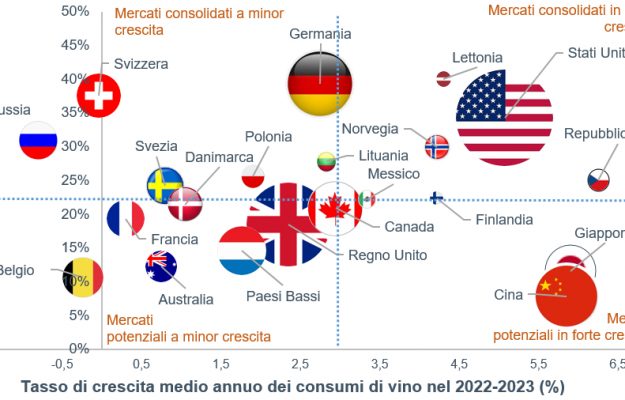Sace, a Ministry of Economy and Finance company specializing in the insurance-financial sector has analyzed Italian wine (among the many various analyses) and presented its report at Vinitaly. The report confirms that Italian wine is in the spotlight in all its complexities and varieties - made up of large and small wineries, emerging and historic denominations, whites, reds, rosés, and bubbles that narrate the territories in the glass. For quite some time, wine has represented twenty-five percent of exports of the Italian agro-food sector. The sector has stayed in positive territory even during the peak of the pandemic, and it still reports excellent performances today. The report emphasized that the “across the border wine sales, one of the leading Made in Italy products, had also continued to grow in 2021, marking + 12.4% increase compared to 2020, equalling a value of 7.3 billion euros”.
Italy, Sace noted, has been reconfirmed as one of the top exporting countries, in terms of volume and value. Specifically, France, Italy, and Spain have confirmed the main world exporters of wine in value. The Italian share has been growing over time and has firmly settled in second place, while Paris has seen its weight drop below 30%. Madrid follows, at 9% of global sales made beyond National borders. Playing in favor of our French “cousins” are, as usual, the prices of wines, which are on average higher than Italian wines, especially comparing “bubbles”: French Champagne on the one hand and Italian Prosecco on the other. Quantity data, on the other hand, shows a much different picture. The largest share is attributed to Spain (20.2%), closely followed by Italy (20.1%), while France represents “only” 13.7%.
In any case, Italy’s position among the top exporting countries benefits also from consistent growth in wine consumption. This is driven by more consolidated geographies such as America (the United States is the number one destination market for Italian wine exports), but also less targeted destinations, but that has high potential, such as, for instance, China and Japan, where the value of Italian wine sales is quite significant, but its presence on the market is still not at full potential.
Italy’s territorial characteristics are the driving force of the good export dynamics for which Italy boasts numerous quality awards. Specifically, in terms of value, in 2021 Veneto wines, more than the others, crossed National borders (almost 2.5 billion euros in exports), thanks, especially to the excellent performance of Prosecco (30% of the Region's exports). In 2021 the Region exported almost 830 million euros in bubbles, up more than +15% compared to 2020. Piedmont and Tuscany follow, then Trentino-Alto Adige, Emilia-Romagna and Lombardy - thanks also to the excellent foreign performance of Franciacorta (+ 10.3%) - and also showed excellent levels of beyond border sales.
Obviously, the impact of the war in Ukraine weighs heavily on the sector. In 2021, the SACE report pointed out, Russia represented the 12th destination market for Italian wine exports (149 million euros, equal to 2.1% of the total exported wines), behind Japan, and ahead of China which registered an above-average growth (+18.4% compared to 2020). However, the effects of the current war conflict between Russia and Ukraine are reflected in the wine sector as well. The supply of raw materials (mainly, aluminum and fertilizers) and energy(production of glass and paper for bottles, labels, and cartons for packaging, which is in fact energy-intensive) have been impacted. We are just beginning to catch a glimpse of the repercussions of these additional costs; however, the duration of the conflict will determine the true extent of its effects on the wine sector’s performance.
Copyright © 2000/2025
Contatti: info@winenews.it
Seguici anche su Twitter: @WineNewsIt
Seguici anche su Facebook: @winenewsit
Questo articolo è tratto dall'archivio di WineNews - Tutti i diritti riservati - Copyright © 2000/2025









































































































































































































